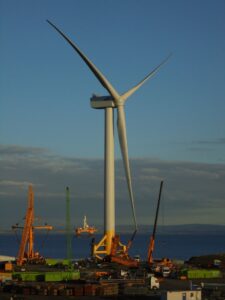
While online shopping is clearly driving growth in the industrial property market, a fledgling industry in Maryland – offshore wind energy – is also creating new demand for industrial space.
During a recent webinar hosted by the Building Congress & Exchange, Brady Walker, Mid-Atlantic Market Manager for Ørsted, discussed some of the real estate and construction needs his company will have as it develops the Skipjack Windfarm near Ocean City and other projects off the shores of the Mid-Atlantic and New England.
Offshore wind farms are “large-scale infrastructure projects that involve quite a bit of development onshore in terms of facilities to build, operate and maintain windfarms as well as landfall and interconnection facilities to bring power ashore,” Walker said. “With a large portfolio of projects – eight up and down the East Coast – Ørsted obviously will make an impact in the region.”
The development company is creating a $13 million, 45-acre offshore wind staging center at Tradepoint Atlantic.
Furthermore, Ørsted has “committed to spending about 34% of the [Skipjack] project’s total CapEx in the state. That’s about $210 million,” Walker said. That will create “about 900 construction jobs to support the buildout of our facilities both in Baltimore and other parts of the state as well as critical components of the windfarm.”
Ørsted is currently working to establish a full supply chain for its East Coast windfarms. That will involve establishing industrial facilities throughout the region, each capable of supporting multiple farms. And Ørsted’s operations could expand further as states work to meet legislated mandates to draw more of their energy from clean, renewable sources.
The Skipjack project is relatively small at just 120 megawatts, Walker said. To meet state mandates, “Maryland has 1,200 megawatts left to procure, New York and New Jersey 9.5 gigawatts and 7.5 gigawatts respectively so there is a lot more work on the horizon.”